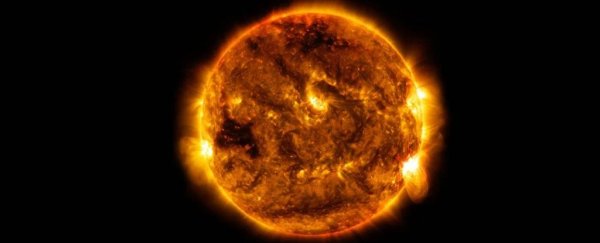On Sunday, Earth's magnetic field was pelted by a solar wind stream reaching velocities of more than 600 kilometers (372 miles) per second.
While that's nothing too alarming – solar storms often pummel our planet triggering spectacular auroras – what is weird is that this storm was totally unexpected.
"This event was not in the forecast, so the resulting auroras came as a surprise," SpaceWeather reported.
Solar wind occurs when a stream of highly energized particles and plasma can no longer be held back by the Sun's gravity and burst out towards Earth.
There's a lot we still don't know about how our Sun works, but these emissions are thought to come from large bright patches on the Sun known as 'coronal holes' and scientists do a great job of monitoring them from here on Earth.
Through this monitoring, they're able to create space weather 'forecasts' that not only predict when solar storms or solar flares, also known as coronal mass ejections (CMEs), are heading our way, but how powerful they'll be.
But that doesn't mean we can't still get surprised like we did over the weekend.
Early on Sunday, NASA's Deep Space Climate Observatory (DSCOVR) noticed light solar wind streams, which increased significantly and unexpectedly throughout the day.
The cause of this solar storm is still unknown, but SpaceWeather speculates it could have been the early arrival of solar wind expected to come from an equatorial hole in the Sun's atmosphere two days later.
Or it could have been a missed coronal mass ejection (CME).
"A discontinuity in solar wind data at 0045 UT on Aug. 7th hints at a shock wave embedded in the solar wind," writes Space Weather.
"These days, the active sun is producing so many minor explosions, it is easy to overlook faint CMEs heading for Earth."
At the time of writing, the high-velocity solar wind continues to slam into Earth's magnetic field, with records showing the speed is reaching 551.3 kilometers (343 miles) per second as of August 9, 0406 UTC (0006 ET).
The good news is that solar wind isn't damaging to us here on Earth, safely protected by our planet's atmosphere.
When it's strong, though, it can impact our technologies, causing issues with telecommunication satellites and, in extreme cases, power grids.
These winds were classified as a moderate G2 solar storm – storms are ranked G1 at the lowest end of the scale all the way up to G5, which is a powerful solar storm.
G2 storms can affect high latitude power systems and could impact the orbit predictions of spacecraft, according to Space Weather.
If you feel like this all sounds familiar, that's because we've witnessed a lot of solar storms this year, with the Sun now in the active phase of its 11-year solar cycle.
Already this year we've been hit by X-class flares and giant coronal holes, more than 2.5 times Earth's size. Most of the time you'd have no idea this was happening.
Unless you're an avid aurora watcher, that is.
Fortunately, followers of the Space Weather Alert Service were notified about the unforecast storm and were able to make it out to see the resulting powerful auroras and Steve, which were seen as far south as Pennsylvania.
"I was already in bed getting ready for sleep when the storm began," astrophotographer Ruslan Merzlyakov told Space Weather.
"Rushing to the beach in Nykøbing Mors, I was able to photograph the first summer auroras in Denmark in 5 years."
Who knows what the rest of the week may have in store for us.
